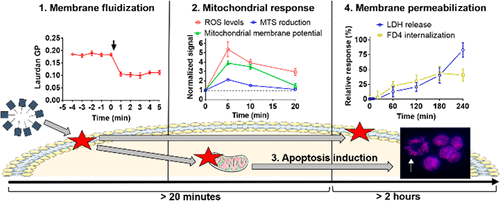当前位置:
X-MOL 学术
›
Mol. Pharmaceutics
›
论文详情
Our official English website, www.x-mol.net, welcomes your feedback! (Note: you will need to create a separate account there.)
Exposure to a Nonionic Surfactant Induces a Response Akin to Heat-Shock Apoptosis in Intestinal Epithelial Cells: Implications for Excipients Safety
Molecular Pharmaceutics ( IF 4.9 ) Pub Date : 2019-01-04 00:00:00 , DOI: 10.1021/acs.molpharmaceut.8b00934 Robert J. Cavanagh 1 , Paul A. Smith 2 , Snow Stolnik 1
Molecular Pharmaceutics ( IF 4.9 ) Pub Date : 2019-01-04 00:00:00 , DOI: 10.1021/acs.molpharmaceut.8b00934 Robert J. Cavanagh 1 , Paul A. Smith 2 , Snow Stolnik 1
Affiliation

|
Amphipathic, nonionic, surfactants are widely used in pharmaceutical, food, and agricultural industry to enhance product features; as pharmaceutical excipients, they are also aimed at increasing cell membrane permeability and consequently improving oral drugs absorption. Here, we report on the concentration- and time-dependent succession of events occurring throughout and subsequent exposure of Caco-2 epithelium to a “typical” nonionic surfactant (Kolliphor HS15) to provide a molecular explanation for nonionic surfactant cytotoxicity. The study shows that the conditions of surfactant exposure, which increase plasma membrane fluidity and permeability, produced rapid (within 5 min) redox and mitochondrial effects. Apoptosis was triggered early during exposure (within 10 min) and relied upon an initial mitochondrial membrane hyperpolarization (5–10 min) as a crucial step, leading to its subsequent depolarization and caspase-3/7 activation (60 min). The apoptotic pathway appears to be triggered prior to substantial surfactant-induced membrane damage (observed ≥60 min). We hence propose that the cellular response to the model nonionic surfactant is triggered via surfactant-induced increase in plasma membrane fluidity, a phenomenon akin to the stress response to membrane fluidization induced by heat shock, and consequent apoptosis. Therefore, the fluidization effect that confers surfactants the ability to enhance drug permeability may also be intrinsically linked to the propagation of their cytotoxicity. The reported observations have important implications for the safety of a multitude of nonionic surfactants used in drug delivery formulations and to other permeability enhancing compounds with similar plasma membrane fluidizing mechanisms.
中文翻译:

暴露于非离子表面活性剂可引起类似于肠上皮细胞热休克细胞凋亡的反应:对辅料安全性的影响
两亲性非离子表面活性剂广泛用于制药,食品和农业行业,以增强产品性能。作为药物赋形剂,它们还旨在增加细胞膜的通透性,从而改善口服药物的吸收。在这里,我们报告了整个和随后的Caco-2上皮暴露于“典型”非离子表面活性剂(Kolliphor HS15)时发生的事件的浓度和时间依赖性连续变化,从而为非离子表面活性剂的细胞毒性提供了分子解释。研究表明,暴露于表面活性剂的条件会增加质膜的流动性和渗透性,从而在5分钟内产生快速的氧化还原和线粒体效应。凋亡是在暴露早期(10分钟以内)触发的,并依赖于最初的线粒体膜超极化(5-10分钟)作为关键步骤,从而导致其随后的去极化和caspase-3 / 7活化(60分钟)。凋亡途径似乎是在表面活性剂引起的大量膜损伤(观察到≥60分钟)之前触发的。因此,我们建议通过表面活性剂诱导的质膜流动性增加,类似于热休克引起的膜流化的应力响应现象来触发对模型非离子表面活性剂的细胞反应。因此,赋予表面活性剂增强药物渗透性的流化作用也可能与它们的细胞毒性的传播有内在联系。
更新日期:2019-01-04
中文翻译:

暴露于非离子表面活性剂可引起类似于肠上皮细胞热休克细胞凋亡的反应:对辅料安全性的影响
两亲性非离子表面活性剂广泛用于制药,食品和农业行业,以增强产品性能。作为药物赋形剂,它们还旨在增加细胞膜的通透性,从而改善口服药物的吸收。在这里,我们报告了整个和随后的Caco-2上皮暴露于“典型”非离子表面活性剂(Kolliphor HS15)时发生的事件的浓度和时间依赖性连续变化,从而为非离子表面活性剂的细胞毒性提供了分子解释。研究表明,暴露于表面活性剂的条件会增加质膜的流动性和渗透性,从而在5分钟内产生快速的氧化还原和线粒体效应。凋亡是在暴露早期(10分钟以内)触发的,并依赖于最初的线粒体膜超极化(5-10分钟)作为关键步骤,从而导致其随后的去极化和caspase-3 / 7活化(60分钟)。凋亡途径似乎是在表面活性剂引起的大量膜损伤(观察到≥60分钟)之前触发的。因此,我们建议通过表面活性剂诱导的质膜流动性增加,类似于热休克引起的膜流化的应力响应现象来触发对模型非离子表面活性剂的细胞反应。因此,赋予表面活性剂增强药物渗透性的流化作用也可能与它们的细胞毒性的传播有内在联系。

























 京公网安备 11010802027423号
京公网安备 11010802027423号